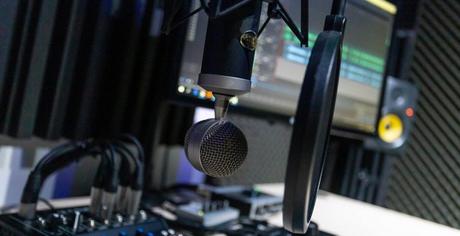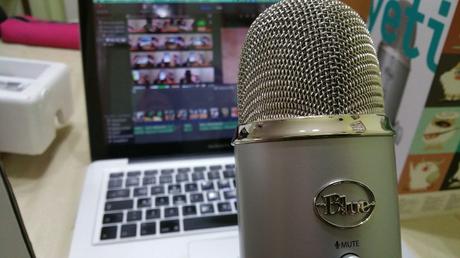It’s 2021 and there are ton of different types of content marketing strategies you could be working on these days. Building your podcast? That’s the talk for today but let’s review some of the others quick.
Blogging is very popular still and telling your story, especially now with so many working remote is increasingly compelling. Writing fleshed out / fully detailed and sourced articles and eBooks are another way to market yourself and your products. You can kick that up a notch and write a book that you use as a lead magnet and/or sell depending on the quality, purpose, and depth of what you write. Social media is also a standard measure of business and we’re all using it today in some capacity.
Podcasting… well that is another option that was already going gangbusters before COVID-19 hit the scene and has just had a meteoric rise since.
First you may want to ask yourself if you want to be a Podcast Host or Podcast Guest? I wrote an article to help you decide (or at least know what you didn’t getting into all of this.)
What is a podcast?
A podcast is a digital audio or video file that you can stream from the internet or download and listen to or watch. They can be watched via a streaming service or downloaded to your mobile device or computer. All niches are covered by podcasts. You can set up a podcasting site or “channel” and make daily podcasts like a radio show.
Edison Research (Edison Research) recently completed a ‘podcast survey’ here in the US. Here are some statistics to really show you just how huge podcasting has become:
- 197 million Americans have heard about podcasts.
- 51% of Americans over the age of 12 have listened to podcasts.
- 32% of Americans listen to podcasts at least once a month.
- 74% of podcast users listen to podcasts to learn something new.
- 65% of podcast consumers are most likely to listen to episodes on a mobile device.
- 52% of podcast subscribers listen to entire episodes.
- Around 26% of podcast listeners increase the speed of podcasts while listening.
So, the next time you are wondering to yourself ‘but WHO will listen to / watch my show?’ the audience is there. In total abundance. It really comes down to you getting it all together and making it happen. The world is ready and waiting to meet you.
Podcasting has many advantages over the other forms of online marketing. You can provide value in a new and more meaningful way. Podcasting is even easier than blogging because you do not need a website to get started. On the other hand, if you have an established business website already, a podcast is an amazing “add-on” to keep Google seeing your site in their algorithm as you post up new episodes regularly.
“Okay Steve, you convinced me. I am going to finally get off my rear end and start up the podcast I’ve been scribbling notes down about for the past 2 years. What do I need to get started?”
It’s really not as bad as some websites and podcast gurus that sell the ‘How to Be a Podcast Superstar Overnight’ garbage courses will try to convince you. You need far less tools than most expect and the cost of entry to get started is not bad at all. (presuming you can do the hump work of editing and promotion yourself) Hell, you may have some of these things already.

Building Your Podcast “Getting Started” List:
You can get started quickly building your podcast with only a couple of tools:
A quality microphone. Fortunately, a good microphone in our technology rich world is only around $50. The Snowball by Blue Microphones is very popular and a quality device. Do a little research and find a microphone that fits your needs and budget. Remember that you’re only recording your voice. You don’t need a microphone that can handle the crushing volume of a drum set.
- In a pinch, a combination headset-microphone can work well enough to get started. Move up to a better microphone when your finances allow.
- The headset combo is also a good option if you’re interviewing others. Remember that you must be able to hear the other person without the sound spilling over into your microphone.
- You may also record audio already or play guitar or another instrument and have a way to “plug-in” to your computer already. A quality XLR mic + USB audio interface will deliver a superior quality over a USB microphone. The cost will be higher but if you know your gear you can do it for a fairly good price. The Behringer U-Phoria UM2 and a MXL 990 mic make a fantastic combination and will not break the bank. I have been using the MXL 990 for the past 15+ years doing voice over work and it performs just as good today as the day I bought it.
A computer or cloud service to store the recordings. There are many alternatives to a computer, but you’ll need a computer to upload your podcast anyway. Unless the plan is to be 100% mobile, which you can do, but understand your overall production quality will likely suffer some. Exceptions to the mobile rule? Absolutely. In fairness it’s typically a technically advanced user who is 100% mobile and has the right gear to get the job done.
Audio Editing Software. There are free programs you can use like XXX and also great paid programs like PreSonus Sphere which now offers themselves as a $15/month service (similar to Adobe / Microsoft / etc..) and you get access to all of their tools, sounds, etc.
For one-time purchases (or ones that have free versions that come with popular gear) Ableton Live is also a great production tool. PreSonus also offers their popular StudioOne software as a one-time purchase so a Sphere monthly bill is not necessary.
If you already are paying for Adobe Creative Cloud you can consider using Adobe Audition since you’ve already paid for it with your CC account (on the Master edition). While not as robust as PreSonus Studio or Ableton Live, for a podcast it can get the job done.
The choice is yours to make but absolutely do a few trials and see what DAW (digital audio workstation) software works best for you. We ALL have our preferences.
That is really all you need to at the very least get started building your podcast. No excuses! A simple microphone and your computer are all you need to record and upload your first podcast. Start looking for a microphone today and you can get started on your first podcast immediately.
“Awesome Steve. I have the gear now and my wife’s 3rd cousin twice removed (he is the IT guy in our family) came over and laughed at me while he set it all up in under 5 minutes. I am ready to rock but… I don’t have a PLAN! ”

Steps to Creating your First Podcast:
Choose a format. There are a few ways to conduct your podcast:
- Go solo
- Have a co-host to work with
- Have one or more guests
- Most podcasters stick to a single format and occasionally change it up. Your listeners will probably grow to expect and like a particular format, but don’t be afraid to vary it on occasion.
Unless you’re very talented, you’ll want notes, if not a full script. If you are interviewing someone, have questions ready. I’m going to be the first to admit I have gone off script more times than not. My personal compromise is to use sticky notes and put them up in advance all around my monitor so while I record, I can ATTEMPT to keep myself on track.
- Consider the purpose of the podcast. What are you trying to share, teach, or explain? Perhaps your podcast is strictly for entertainment purposes.
Record in a quiet space. People do not enjoy listening to anything with a lot of background noise, it is distracting as hell and shows a lack of professionalism. Nobody wants to hear the 8:15 train in the middle or your podcast, unless it’s a show about trains!!!
Edit appropriately. Ensure that any guests who participated in your podcast have the opportunity to review your edits before making the podcast public.
What could be easier? It can be a little more intimidating to put your voice online than writing a blog post, that’s for sure. But it’s also more effective. You’re putting a part of yourself out there for the world to experience. Some will love it, some may hate it. At the end of the day you need to put the content together you believe in and share it to your audience.
Once you have recorded your podcast, it’s time to make it available to others. Unless you just want to keep listening to it alone in your office. I’ll leave that up to you. The rest of us though… we want to share our efforts with the world! How do we do this? Simple.

Podcast Syndication and Promotion
You can send out your podcast in several ways:
Create an RSS feed. You can upload your podcast to a single site and it will automatically be delivered to your subscribers. I use Spreaker to host my podcast and also have recommended it to dozens or people still using their tools today. Lightning-fast delivery, good stats, and helpful customer support. Win-win for me.
Use iTunes. iTunes will also deliver your podcast to subscribers; People will also be able to search for it.
- After uploading to iTunes, you can expect it will take approximately 5-7 days until your podcast is available. There is a review process. Make sure you have AT LEAST FIVE episodes to upload when you start. Also prepare a social media campaign to go with it so you can promote those seed episodes and get as much of a jump on iTunes that you can.
Upload your podcast to other sites. Soundcloud is a popular platform and provides multiple sharing options. Also consider Google Plus, Spotify, and others. Spreaker has a list you can auto-publish to when you use their platform to host your show.
Use social media. Tell everyone about your latest podcast. Get every listener you can find. They’re all potential customers. Make sure you keep a social media schedule. Announce your guests or episodes weekly. Make social media posts to promote it before and after the show airs. Use a tool like Canva to make your own graphics if you work alone. Don’t let fear stop you from getting your logo / background graphic / episode title onto a JPG to share on social. You CAN do it. Will it be graphic designer quality? No. The world won’t stop because of that either.
Use your imagination. Market your podcast any way you can. Every loyal listener is potentially another opportunity.
Fast forward 6 months (or less if you have the hustle, following, and a little bit of luck when building your podcast) and now that you have a show with listeners, the next step is monetization. It’s time to boost your income.
“Steve the podcast is going great!! Thanks for the help. But what do you mean ‘boost my income’ I can make money with the podcast itself? How on Earth is that done??”
Monetizing Your Podcast:
Sell your own products. Do you have a course or other product for sale? You can use your podcast to promote your products and business. The show can be about your product, or you can casually mention it during the show. In your podcast, entice people to visit your website where they can buy your products.

FYI – I’m not a fan of making episodes solely about your product / service. It comes off a little crass and lack the building blocks of trust that everyone should be implementing in your business. Weave it into the story as part of the solution, the case study style of introduction to your product will be helpful enough!
Sell your podcast. This is for a limited group of people in an extremely niche market and can at times work really well. For the rest… Having “restricted-access” when nobody knows who you are is just an unnecessary uphill battle. You are putting up a wall instead of using your podcast as a value-building tool.
Charge for advertising. Make money by charging other companies for advertising on your show. This works especially well once you’ve built an audience. Find companies who sell products to your target audience. Run a prerecorded commercial or promote the company in the context of your show. Make sure it’s something that compliments your podcast and benefits your listeners. Nobody wants to hear an out of context ad just so you can turn a buck on the internet. Partner up with companies that make sense and provide value.
Affiliate Marketing. You can offer products through affiliate links like Amazon on the actual web page of your website where you display the podcast. It won’t directly make you income on every listener, but for the percentage of people that find you through the web they will see your links. You can also provide a “list” of items on the episode pages of your website and direct listeners there. Say you had an episode about TV’s. You could tell your listeners, “Don’t forget to check out the full list with links from today’s chat on the website. Episode 34 on the Url.com/podcast page”
Display Advertising. Similar to Affiliate links you could run Display Network ads on your website through Google’s ad networks among others. Depending on your website the ads may be all over the website, or only on the podcast episode pages. Be careful not to overrun your site with ads. If your site is a professional site I would recommend sticking to the Affiliate Ads since they can be displayed only on the relevant pages and not take away from your actual business.

Steve’s Pro Tip:
Maybe it’s not about $ and instead you build this as VALUE from your brand to attract the right clients and build trust in your marketplace.
Look. It’s a lot to take in for one sitting. The goal now is to grab a sheet of paper and map out your ideas. Make lists of what you have and need. Content you may have ready to go. Hardware and software you may require or upgrade, etc.
Put a plan in place to tackle a few tasks a week so you can prepare for a launch date. If you are recording solo make a priority to getting a microphone setup so you can start recording episodes while sorting everything else out.
I have helped a lot of companies plan their podcast launch. From conception to release. It’s a LOT of work but remember the majority of the work is 1-time items to get the machine in place and humming.
Your weekly routine will end up being simple, relatively speaking. Record -> Edit -> Release
Of course, you’ll need promotion posts / social media / etc. but that is something you can farm out or have someone on your team handle for you.
Is building your podcast a lot of work? Yup. But…. it’s absolutely obtainable for anyone with an idea, some basic equipment, and the desire to create something uniquely yours!
